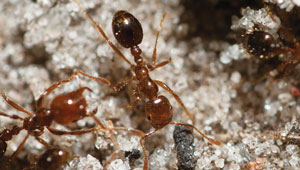Ant management may be challenging because of several factors: unfamiliar or invasive species, multiple nests, conducive conditions, and uncooperative customers. The following tips from pest management professionals who offer ant management services may help you conquer callbacks and retain your customers. For more ant management information, check out the 2024 Ant Management Supplement.

Photo: ©Gene White
Charge for the value you bring [to customers] for ant management services. Whether you are on site 5 minutes or 50, your value is in safely solving the issue.
Don’t sell ant control as a one-time service; turn it into a regular service.
— Bill Haynes, Co-owner, Haynes Exterminating, Buford, Ga.
Inspect thoroughly to ensure you don’t miss multiple entry points or colonies.
Don’t wait until there’s already a problem before addressing ants.
Don’t ignore utilities, deck supports, or trees and other foliage when inspecting for ants.
Make integrated pest management (IPM) recommendations, such as cleaning up spills, resolving moisture issues, etc.
Use a proactive approach to help prevent ants before they become an issue.
— Alex McCurter, Training Manager, Mantis Pest Solutions, Lee’s Summit, Mo.
Provide a thorough inspection and price accordingly with follow up services included.
Educate your customer on what they should expect after the service to avoid callbacks.
Read product labels before treating.
Don’t inspect the ground level only; inspect the roof as well.
— Giancarlo Fernandez, President, Solaris Pest Solutions, Santa Clarita, Calif.
Laziness and unwillingness to get into a crawlspace is a reason for ant control failure.
Don’t overlook houseplants and wiring as ways ants enter homes.
— Greg Kelly, Operator, Green Kastle, Sesser, Ill.
Use an integrated pest management (IPM) approach: inspect, identify, treat and monitor.
Report conducive conditions — water, sanitation, entry points — to your customers.
— Greg Bausch, Vice President, American City Pest & Termite, Gardena, Calif.
Ensure equipment is cleaned thoroughly between using repellent and non-repellent insecticides, to prevent cross-contamination.
Don’t treat all ant species the same.
Don’t neglect customer education regarding exclusion and sanitation issues.
Ants may prefer certain baits at certain times of the year depending on their needs, and techs may not know or remember this.
— Natasha Wright, BCE, Technical Director, Braman Termite and Pest Elimination, Agawam, Mass.
If using baits, treat when ants are active to be sure they’re taking bait back to the colony.
Opportunities for ant management services are plentiful because ants are everywhere and in every type of structure, and customers have a low threshold for ants; they want them gone as soon as possible.
— Grady Jones, Owner, Honest Termite, Las Vegas, Nev.
Set expectations for the homeowner before and after treatments.
Seal any cracks and crevices on the interior and exterior of the home.
Without proper knowledge of the ants, homeowners’ home remedies may push ants farther or make colonies bud.
Spray foam insulation may block a lot of important inspection areas; ants may nest inside the foam as well.
— Rick Roseberger, Service Supervisor, Thomas Pest Services, Schnectady, N.Y.
Leave A Comment